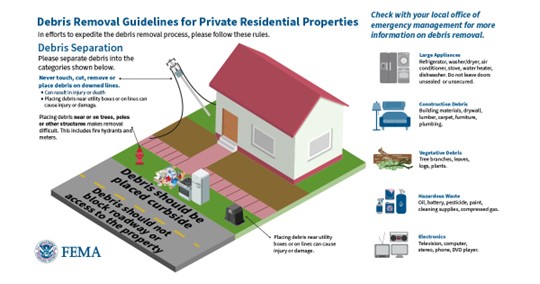After the February severe storms and floods, homeowners may have questions or concerns about how to remove storm debris from their private property. Here are some tips that may be helpful.
Debris includes, but is not limited to:
- Vegetative debris
- Construction and demolition debris
- Sand
- Mud
- Silt
- Gravel
- Rocks
- Boulders
- White goods (large domestic appliances such as refrigerators and washing machines)
- Vehicle and vessel wreckage
Please be aware that snow-related activities, including road clearing, are not considered debris operations, as snow is not considered a form of debris.
Removing debris can be a challenging job. As homeowners, you may remove debris or hire help through insurance settlements. You may also get help removing storm debris from citizen volunteers, the private sector and voluntary organizations.
Local governments often will dispose of disaster-related debris that private property owners place at the curb for pickup on a scheduled date.

Tips for cleaning up debris on private property:
- Stay safe. Wear protective gear such as gloves and masks when handling debris. Contact your local emergency manager if your property is littered with storm-related debris that you suspect poses a threat to public health or safety. As you clear debris, look carefully for any visible cables – such as electrical lines. If you see any cables, wait for professionals to handle them.
- Avoid toxic substances. If you suspect the debris contains dangerous ingredients, seal them in plastic bags to prevent them from becoming airborne. Don’t burn debris you suspect may be toxic.
- Check with local officials before placing debris for collection.
- Place debris away from trees, poles or structures including fire hydrants and meters.
- Do not block roadways with debris.
When in doubt, contact your local emergency manager for guidance. To find your local emergency manager and other local resources, visit www.fema.gov/disaster/4860#local-resources.
For more information about Kentucky flooding recovery, visit www.fema.gov/disaster/4860. Follow the FEMA Region 4 X account at x.com/femaregion4.

